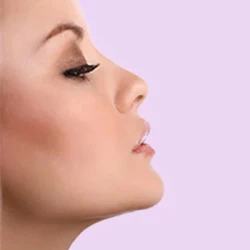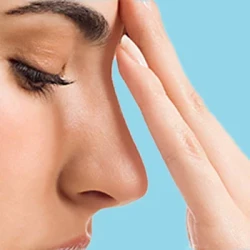Bumps on Nose After Rhinoplasty: Causes and Treatment
- ByMedical Content Team
- Medically Reviewed byDr. Sabine Kulhanek
Fact checked
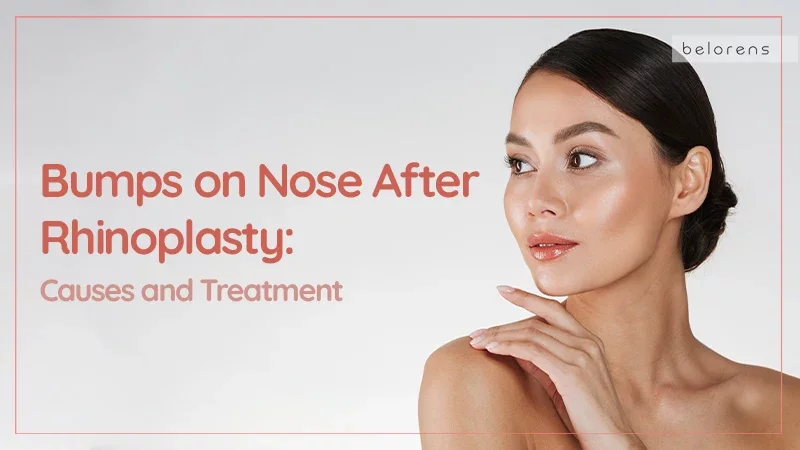
The allure of a nose job lies in the promise of a refined and harmonious facial profile, setting the stage for a new chapter of self-assurance and beauty. However, the discovery of bumps or irregularities post-surgery can shatter the dreams of flawless results, leaving individuals grappling with a sense of disappointment and disillusionment. As the mirror reflects unexpected imperfections, individuals embark on a proactive journey toward finding solutions to address these remaining nuances.
Bumps on the nose after rhinoplasty can occur in some cases, but they are not considered common for every patient who undergoes the procedure. The likelihood of developing bumps after rhinoplasty can vary depending on factors such as the surgical technique used, the complexity of the procedure, individual healing processes, and the skill and experience of the surgeon. While bumps are a known potential complication of rhinoplasty, they do not necessarily affect every patient and can often be managed effectively with proper care and, if needed, appropriate interventions.
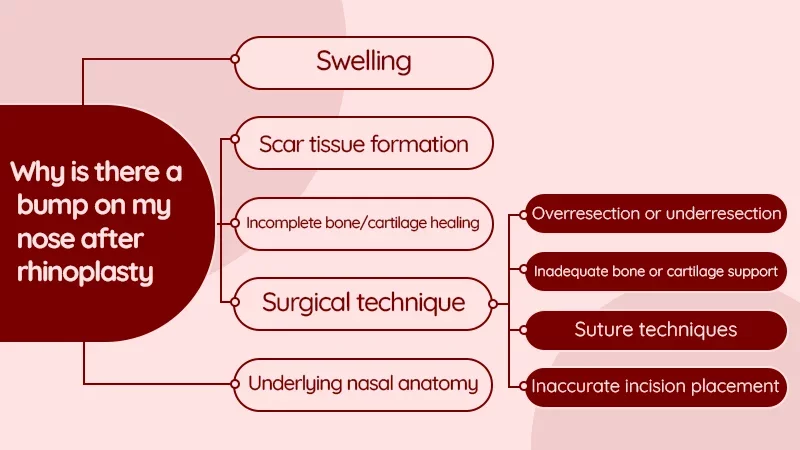
Why is there a bump on my nose after rhinoplasty
The presence of a bump on your nose after rhinoplasty can be attributed to a variety of reasons. Initial bumps and irregularities, which can persist for a few months, are typically a result of swelling in the nasal tissues, including the skin, muscles, and periosteum.
Given the fact that it may take a year or longer for the swelling to completely diminish post-surgery, the presence of a bump during the early stages of healing is usually not alarming. Patients who had prominent bumps before rhinoplasty often experience more pronounced swelling. Individuals with significant nasal bumps or a background of facial trauma or nasal fractures may need multiple procedures to achieve a refined and straight nasal profile.
There are other causes as well. Here are the main causes of bumps and lumps after nose surgery.
Swelling
Swelling is a common cause of bumps and lumps after rhinoplasty. Postoperative swelling is a natural part of the healing process and can lead to temporary irregularities in the nasal appearance. In the early stages of recovery following rhinoplasty, swelling can mask the final results of the surgery and create the appearance of irregularities on the nose. As the swelling gradually subsides over time, typically within weeks to months, the nose's shape and contours will continue to refine, and any visible bumps or irregularities may diminish.
Scar tissue formation
Scar tissue formation can be a contributing factor to the development of bumps on the nose after a nose job procedure. During nose surgery, incisions are made to reshape the nasal structures, and the body responds to these incisions by forming scar tissue as part of the natural healing process.
In some cases, excessive or irregular scar tissue formation can lead to the appearance of bumps or lumps on the nose post rhinoplasty. This scar tissue may not always settle evenly or smoothly, resulting in visible or palpable irregularities on the nasal surface.

Incomplete bone/cartilage healing
If the bones or cartilage in the nose do not heal properly or fuse together unevenly after surgery, it can result in the formation of a bump or asymmetry. During rhinoplasty, the nasal bones and cartilage are often reshaped or repositioned to achieve the desired aesthetic outcome. However, if the bones or cartilage do not heal properly or if there are irregularities in the healing process, it can lead to the formation of bumps or asymmetries on the nose.
Surgical technique
Errors in surgical technique, such as inadequate correction of a dorsal hump or improper reshaping of the nasal structures, can lead to the formation of a bump on the nose. The skill and experience of the surgeon play a crucial role in achieving optimal surgical outcomes and minimizing the risk of complications or aesthetic irregularities.
Some ways in which poor surgical technique can contribute to bumps on the nose after surgery include:
- Overresection or underresection: Inadequate or excessive removal of bone or cartilage during rhinoplasty can result in an uneven contour or asymmetry, leading to the formation of bumps or lumps on the nose.
- Inadequate bone or cartilage support: Insufficient support or inadequate reinforcement of the nasal structures during surgery can cause the nasal tissues to shift or settle improperly, resulting in irregularities on the nose.
- Suture techniques: Improper placement or tension of sutures used to close incisions can impact the nasal shape and contribute to the formation of bumps or indentations.
- Inaccurate incision placement: Incisions made during rhinoplasty must be precise and strategically placed to minimize scarring and ensure proper healing. Poorly placed or excessive incisions can lead to visible irregularities on the nose.
Also Read: How to Choose the Right Rhinoplasty Surgeon
Underlying nasal anatomy
The natural anatomy of the nose, including the thickness of the skin, the strength of the cartilage, and the presence of bone spurs, can influence the appearance of bumps after surgery. underlying nasal anatomy can be a significant factor contributing to the development of bumps on the nose after rhinoplasty. The nasal anatomy varies among individuals, and factors such as the thickness of the skin, the structure of the underlying cartilage and bone, and any pre-existing irregularities can influence the surgical outcome and the potential for bumps or asymmetries to occur postoperatively.
Bump on the tip of the nose after rhinoplasty
A bump on the tip of the nose after nose surgery can be a common concern. This bump can result from various factors, including residual swelling, cartilage irregularities, or scar tissue formation. It is important to note that postoperative swelling, especially in the tip area, can take longer to resolve compared to other parts of the nose. In some cases, the appearance of a bump on the tip of the nose may be temporary and part of the normal healing process. However, if the bump persists or causes cosmetic concerns, it is advisable to consult with your surgeon for further evaluation and guidance on potential treatment options.
Learn About Each Nose Concern and Find Its Solutions:
Dorsal Hump Removal
Crooked Nose Solutions
Wide Nostrils Solutions
Bulbous Tip Solutions
All Nose Solutions
Bump on the side of the nose after rhinoplasty
A bump on the side of the nose can be a concern after rhinoplasty and may be attributed to various factors such as residual swelling, asymmetrical healing, cartilage irregularities, or scar tissue formation. It is essential to allow sufficient time for the postoperative swelling to subside as it can impact the nose's overall appearance, including the sides. If the bump persists or causes cosmetic distress, it is advisable to consult with your surgeon for a thorough evaluation and to discuss potential treatment options, which may include non-surgical interventions or revision rhinoplasty to address the issue effectively.
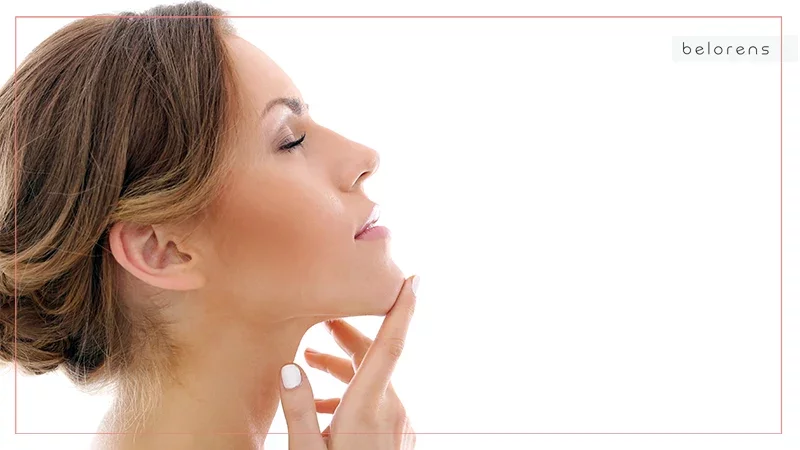
Dorsal hump after rhinoplasty
In most cases, rhinoplasty patients with a dorsal hump want their surgeons to completely remove the hump and straighten the nasal bridge — and even give it an upward curve. Therefore, if contrary to the patient’s expectation, the nasal bridge still has a bumpy appearance after the surgery, there can be several reasons for this:
- Swelling: Postoperative swelling is a common occurrence after rhinoplasty and can persist for several months. The swelling can sometimes give the appearance of a bump even though the underlying structures have been altered during surgery.
It may take around six to seven months for the upper nose to display the full changes from rhinoplasty, whereas the lower nose may require one to one and a half years for complete transformation. Consequently, what may appear as a bump on the bridge of the nose post-surgery could be attributed to lingering swelling or incomplete skin re-adaptation over the nose. - Incomplete correction: If the initial surgery did not address the dorsal hump adequately, there may still be a bump present on the bridge of the nose. These residual cartilage or bone along the bridge of the nose can contribute to the presence of a bump.
- Scar tissue formation: Scar tissue can form during the healing process, leading to irregularities or bumps on the bridge of the nose.
Should I have a revision surgery to correct the bump?
Deciding whether to undergo revision nose surgery to correct a bump after rhinoplasty is a personal choice that should be carefully considered in consultation with your surgeon. Here are some factors to consider:
- Persistence of the bump: If the bump persists long after the initial surgery and is causing significant cosmetic concerns, you may consider revision surgery to address the issue.
- Impact on functionality: In some cases, a bump on the side of the nose may also affect nasal function, such as breathing issues. If this is the case, revision surgery may be necessary to improve both aesthetics and functionality.
- Surgeon's recommendation: Your surgeon can provide valuable insight into whether revision surgery is the best course of action based on their assessment of the bump and your individual circumstances.
- Healing time: It is important to allow sufficient time for the initial rhinoplasty swelling to resolve before considering revision surgery, as postoperative swelling can impact the nose's appearance.
Ultimately, the decision to undergo revision surgery should be made collaboratively with your surgeon after a thorough evaluation of the bump and a discussion of the potential benefits and risks associated with the procedure.
Also Read: Do's and Don'ts After Rhinoplasty Surgery

What are the options to remove the bump after rhinoplasty?
Depending on the bump's location, a surgeon will employ different techniques for its removal. If the bump is the result of residual bone or cartilage after surgery, a surgical procedure may be performed to remove it.
A bump situated in the upper part of the nose consists of bone, whereas a bump in the mid to lower nose comprises cartilage. Therefore, during revision surgery, bony bumps are typically filed down, while cartilage bumps are excised. The skin re-adapts more quickly over the upper nose compared to the lower nose due to varying skin thickness along the nose's length.
Non-surgical options to remove post-rhinoplasty bump
There are non-surgical options available to address a bump on the nose after rhinoplasty, depending on the nature of the bump and the desired outcome. Some non-surgical treatments that may help improve the appearance of a bump on the nose include:
- Injectable fillers (nose fillers): Dermal fillers can be used to camouflage minor irregularities or bumps on the nose by adding volume to surrounding areas, creating a smoother contour.
- Steroid injections: In cases where the bump is due to residual swelling or scar tissue, corticosteroid injections can help reduce inflammation and promote tissue healing, potentially minimizing the bump's appearance.
- Hyaluronic acid fillers: Hyaluronic acid fillers can be used to temporarily reshape the nose and improve symmetry, especially in cases where minor adjustments are needed.
It is essential to consult with a qualified and experienced cosmetic surgeon or dermatologist to determine the most suitable non-surgical option for addressing the bump on your nose after rhinoplasty. They can assess your specific concerns, recommend the appropriate treatment, and discuss the potential benefits and limitations of non-surgical interventions in your case.
Takeaway
Bumps on the nose after rhinoplasty can be caused by various factors such as swelling, scar tissue formation, incomplete bone or cartilage healing, surgical technique errors, and underlying nasal anatomy. In some cases, the bump may be temporary and resolve as the healing process progresses. However, if the bump persists or becomes more pronounced over time, it is essential to consult your surgeon for an evaluation. They can determine the cause of the bump and recommend appropriate treatment options, which may include steroid injections, revision surgery, or other interventions to address the issue and achieve the desired aesthetic outcome.
